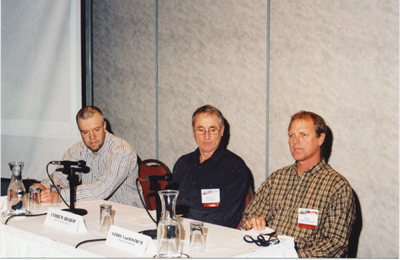
There was lots of experience to share involving the growing of Gala apples in the Maritimes during this past winter’s Nova Scotia Fruit Growers Association meeting.

|
| Apple growers (left to right) Andrew Bishop, Gerry Van Oostrum and Geoff Hennigar shared their experiences growing Gala during a producer panel segment at the 2009 Nova Scotia Fruit Growers Association meeting. (Photo by Dan Woolley)
|
There was lots of experience to share involving the growing of Gala apples in the Maritimes during this past winter’s Nova Scotia Fruit Growers Association meeting.
A small group of apple growers shared their experiences of the dos and don’ts of the variety during a producer panel segment at the conference.

|
|
| Thinning Gala is an absolutely must, according to all of the panelists, and pruning is another important element of variety management.
|
Canard Orchards
Gerry Van Oostrum of Canard Orchards grows Pacific and Royal Gala varieties on M9 rootstock and believes growers must control the vigorous variety from the beginning. “Apply thinner right from the start,” he recommends, adding that as his Gala planting has aged, he uses naphthalene-acetic acid (NAA) more frequently. During the 2008 season, he also gave MaxCel a try, finding the plant growth regulator did not reduce fruit size.
As his Gala trees have aged, pruning has become more important for Van Oostrum, who says he spends more time trimming Gala than any other variety he grows. He does a lot more header cuts on Gala and cautions growers to be vigilant as the variety is very susceptible to fire blight, which he controls using Apogee. “Perhaps, one application would be enough,” he says.
When it comes to pest control, Van Oostrum says growers should be on the lookout for apple mites. “You don’t want to let mites go or you will have awfully small, poorly developed Gala,” he says, adding the variety can be very high-yielding – “probably higher than MacIntosh” – and produces moderately sized fruit.
Harvest begins in Canard Orchards’ Pacific Gala planting around the same time as Honeycrisp, the last week of September and the first week of October.
Van Oostrum believes the big advantage Pacific Gala has over Royal Gala is the fact the variety can be harvested in two picks, rather than three for the Royals.
Noggins Corner Farm Ltd.
Andrew Bishop has 30 acres of Gala on M26, B9 and M9 rootstocks. He currently harvests up to 1,300 bushels using five-foot by 14-foot spacing for his Regal Royal trees and six-foot by 14-foot for Imperial Pacific.
Thinning – both by hand and spraying – “is an absolute must,” Bishop says. He uses Sevin plus an acid thinner, adding that in his early years he over-thinned the variety. “I have cut my thinning rate in half,” he says.
Because of fire blight, Bishop suggests growers pick their planting sites carefully, especially if they plan to establish an orchard next to an existing planting.
Growers should gear their production to both orchard fertility and pruning, Bishop recommends, adding, “Spur pruning is the first step to get what you want at the end of the day.”
Colour can be an issue with Gala and Bishop says he prefers a Royal Gala with a red stripe on a yellow background. He has observed colour problems with the variety on M26 rootstock when the orchard block is over-cropped.
Although some growers have achieved nice colour results using reflective cloth, Bishop reminds them they need to remember Gala is a commodity apple and not Honeycrisp.
According to Bishop, the use of a plant growth regulator, such as ReTain, “is a must” as larger Gala apples can crack, especially during second and third picks.
Doug Nichols, an apple researcher with NSFGA, adds that the rate of ReTain applied is very critical when it comes to Gala. If it’s too high, the plant growth regulator could impair the apple’s colour development, he says.
“Yes, do plant Gala,” Bishop says. “It is a very grower-friendly apple.
“But be very careful what you do plant. It is a two-to-three-pick apple. Two-to-three-picks can be hard to get back to because it will interfere with (harvesting) other varieties.”
Blomidon Farms Ltd.
Geoff Hennigar first planted Royal Gala 10 years ago on heavy soil, supporting his trees using a vertical axis trellis at a six-foot by 14-foot spacing.
He’s learned that thinning is “a big thing” in Gala management and he does it using Sevin XLR and acid. He also used the plant growth regulator MaxCel in 2008 but did not obtain the results he was looking for.
When it comes to pruning, “Gala has to be cut back,” Hennigar says. “Ignore pruning tips, and the variety will grow so much it will strain the trellis.”
Lately, Hennigar has noticed the colour of Royal Gala fruit has become very pale and resembles “an old-fashioned Delicious in appearance.” He has also found that achieving consistent fruit size in his Gala block has been an issue and feels the source of the problem could be the use of M26 rootstock. “Even with aggressive hand-thinning, M26 has had a great deal of issues with snapping off at the union,” he says, adding he plans to look at different rootstock and spacing as the farm develops “large, large trees on the trellis.”
For fertility, Hennigar applies one annual application of a calcium, boron, and nitrate mixture, as his orchard’s soil is “aggressive” and Gala’s fertility is very good.
For mite control mites, he uses a seaweed extract and has achieved very good control with it.
Print this page